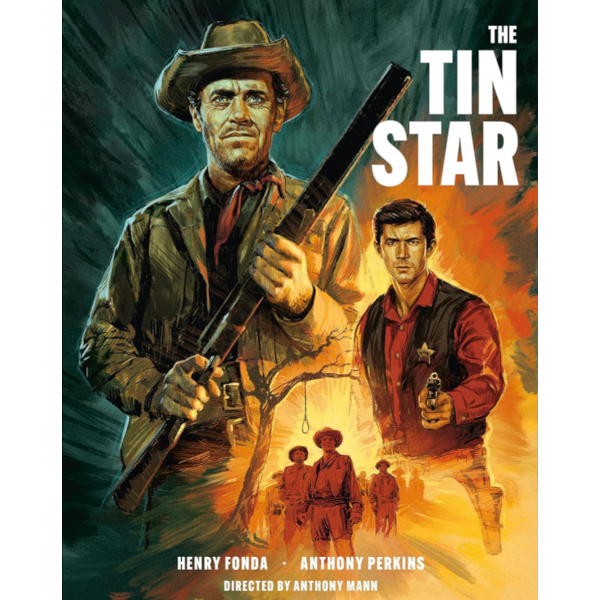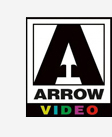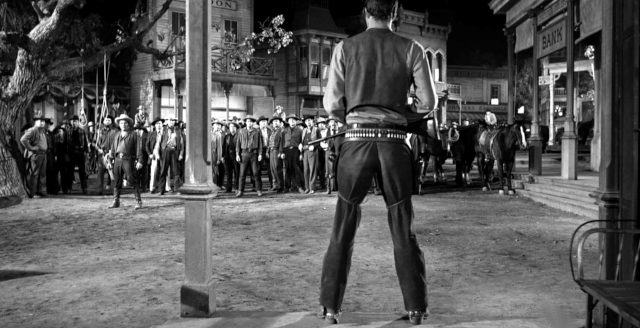The Tin Star
Anthony Mann’s high-quality conventional western has top stars Henry Fonda and Anthony Perkins, plus good input from Neville Brand, John McIntire and especially Betsy Palmer. Perkins takes lessons in how to be Marshall Dillon, while the womenfolk fuss and slimy Lee Van Cleef shoots nice people in the back. We get a Cold War lesson about Law & Order — that looks sensational in B&W VistaVision. Extras include critical input from Toby Roan, Neil Sinyard and Barry Forshaw.

The Tin Star
Blu-ray
Arrow Video USA
1957 / B&W / 1:85 widescreen / 93 min. / Street Date April 30, 2024 / Available from Arrow Films U.S. / 39.99
Starring: Henry Fonda, Anthony Perkins, Betsy Palmer, Michel Ray,
Neville Brand, John McIntire, Mary Webster, Lee Van Cleef.
Cinematography: Loyal Griggs
Art Directors: Hal Pereira, J. McMillan Johnson
Film Editor: Alma Macrorie
Original Music: Elmer Bernstein
Written Screenplay by Dudley Nichols from a story by Joel Kane & Barney Slater
Produced by William Perlberg, George Seaton
Directed by Anthony Mann
 The western genre practically exploded on TV in 1957, which is probably what cued feature director Anthony Mann into thinking it was time to move on, that perhaps bigger epics might provide the path forward. Away from James Stewart, he’d make his more dark & personal Man of the West, one of his few features that didn’t show a profit. But Mann also contracted with the Paramount team of William Perlberg and George Seaton, producers with occasional prestige box office successes: Miracle on 34th Street, The Country Girl, The Bridges at Toko-Ri.
The western genre practically exploded on TV in 1957, which is probably what cued feature director Anthony Mann into thinking it was time to move on, that perhaps bigger epics might provide the path forward. Away from James Stewart, he’d make his more dark & personal Man of the West, one of his few features that didn’t show a profit. But Mann also contracted with the Paramount team of William Perlberg and George Seaton, producers with occasional prestige box office successes: Miracle on 34th Street, The Country Girl, The Bridges at Toko-Ri.
The Tin Star is unlike any of Mann’s westerns — it’s less violent than any of the James Stewart westerns, and its heroes aren’t conflicted or neurotic. When Jim Kitses kicked off a critical reassessment of Anthony Mann and Budd Boetticher, The Tin Star was pretty much ignored. It’s as close as Mann came to a family values western, away from his own trend toward dark revisionism.
Just the same, this is quality filmmaking. The Dudley Nichols screenplay is solid and the performances are expert. Some characters seem too cast-to-type, but other choices, like the under-used and under-appreciated Betsy Palmer ( Mister Roberts) show excellent judgment.
There are few surprises in the narrative setup — Mann’s show may have given Sam Peckinpah ideas on how to formulate TV’s family-sensitive The Rifleman. The experienced bounty hunter Morg Hickman (Henry Fonda) brings the body of a wanted man into town, and gets a less than friendly reception. But he makes good connections with some of the town’s gentle folk. Widow Nona Mayfield (Betsy Palmer) is clearly looking for someone to help her raise her half-Indian son Kip (Michel Ray). Morg’s knowledge of guns and gunmen is also solicited by greenhorn Sheriff Ben Owens (Anthony Perkins), who wants to remain in office even though nobody in town takes him seriously. Ben wants some fast lessons on how to face up to the town troublemaker Bogardus (Neville Brand).
Morg Hickman at first advises Ben Owens to quit the dirty job. Ben’s steady girl Millie Parker (Mary Webster) has the exact same idea: her dead father held the office previously, and she refuses to marry a lawman. But Ben wants to keep the job — he likes the authority and has ideas about being respected and ‘becoming a man.’
We can almost see the wheels spinning between the producers and the agents, thinking that Fonda and Perkins were perfectly cast to type. But did the actors really want these parts? Anthony Perkins made a strong ‘troubled young man’ in William Wyler’s Friendly Persuasion (due out soon in a new remaster), and had continued in that vein in Fear Strikes Out. His film just previous was another western, casting him as the son of a troubled outlaw. After the father figures of Gary Cooper, Karl Malden and Jack Palance, we now have Perkins as another kid seeking guidance, this time from Henry Fonda, who still holds the prize as the greatest western marshal of them all. The story of an inexperienced Sheriff learning to stay alive is a good example of great talent working somewhat below their potential.
Residual fallout from the High Noon ideological fracas.
Dudley Nichols’ script is leavened with a few social messages, some progressive and others less so. To some degree this is a conservative Cold War movie, with the warning that eternal vigilance is the price of freedom in a dangerous world. Henry Fonda is on hand to let us know that disloyal mayors and venal businessmen aren’t worth a Sheriff risking his life over – but a real man does it anyway. It’s the Marshal Dillon Philosophy at work: wearing a badge and using violence to put bad guys in their place is the best thing for the soul. Young Ben Owens learns to command authority with confidence, and not be pushed around by a woman who wants somebody else to keep the peace. The disillusioned Morg Hickman had a family once, but lost it because uncaring citizens wouldn’t help him when he needed it. Helping Ben and Nona Mayfield inspires him to give domestic life another go with a new family. See, we can be the World’s Policemen AND be civilized family men.
The best parts of the film are Fonda’s marshalin’ lessons. Fonda projects integrity, trust, and conscience. He affects a way of walking, talking, and handling guns western-style that’s pleasurable to watch. This is an American Ideal. Scenes of shootin’ practice are of course a requirement of westerns that pass the baton down to a new generation. Where are our future peacemakers going to come from? These target practice scenes are particularly well done, even if two gunshots produce three hits in the water in one take. Morg also critiques young Ben’s fumbled confrontations with Neville Brand’s ogre-like bad guy Bogardus. It’s as if the seasoned lawman were advising a rookie on his golf swing.
Evil in this cozy western town is easily defined, isolated and eliminated. Bogardus is a definite ‘deplorable’– a bad guy, hothead, overt racist and lynch mob instigator. He sneers at Perkins, sneers at Law & Order and just plain needs to be put in the ground. If only real problems were this unambiguous. All Ben needs to do, it seems, is stop acting like a wuss — bullies can’t stand up to righteous folk, you know.
We first saw The Tin Star at about age twelve, when Neville Brand’s Bogardus seemed to represent every bully that terrorized a schoolyard. He’s sullen, aggressive and not likely to listen to reason. Ben’s girlfriend Millie was an irritation, whining about not wanting to marry a man with a badge. What does she want Ben Owens to, change his name and go open a motel? By withholding marriage (and by extension, her favors), Millie even incurs sharp words from the kindly town doctor: her duty is to shut up, marry and start making little Perkinses.
Screenwriter Dudley Nichols touches all the bases. Racial equality was big, so Fonda’s Morg Hickman learns a lesson in civility from available widow Betsy Palmer. The axiom, ‘a good Indian is a dead Indian’ gets wheeled out as a lie to be unmasked. Morg is at first bothered when he finds that Palmer’s husband was a Native American lynched because of his color. But the main conflicts are mostly superficial — just Bad Men, not Problem Institutions. Two part-Indian locals become killers and threaten Betsy Palmer’s boy. One of them is played by Lee Van Cleef. It’s interesting that Van Cleef would later become a star in Italy because he was more affordable than Henry Fonda.
Morg Hickman claims he wants to move on but he and the widow Mayfield eventually hook up without as much as a proposal scene. Too mushy, I suppose. It’s enough to know that they’re going to find another town that needs a Sheriff. That’s what real men do best, it seems.
Anthony Mann’s visual control is always present. He moves the camera in ways that never seem superfluous, and his compositions of people in groups are masterful. Henry Fonda occasionally lurks about the periphery of crowd scenes, watching various public rituals. We always pick him out from the extras, without any special lighting or emphasis.
The film isn’t a stretch for Fonda or Perkins, but both give the material a good uplift. Betsy Palmer’s ‘wholesome and healthy’ woman is quite appealing; we wish she had a bigger starring career. It almost looks as if Neville Brand inherited the nasty creep parts vacated when Ernest Borgnine was promoted to full stardom. John McIntire’s biggest role for Anthony Mann was the colorful villain of The Far Country, but he’s just as solid playing this movie’s less-flamboyant town doctor. Favorite bad guy Lee Van Cleef’s screen image didn’t really develop at all in these years, but this role is more substantial than most.
TV actress Mary Webster was in one Jerry Lewis film but is now known almost exclusively for Master of the World opposite Charles Bronson. Michel Ray got the lead role in the surprise Oscar winner The Brave One. Paramount cast him as the leader of The Space Children, and he ended up with an honorable, if invisible, character credit in Lawrence of Arabia.
The Tin Star reminds us that plenty of ’50s westerns were not trying to stretch the genre with adult content. More challenging takes on the Law & Order issue can be found in Delmer Daves’ 3:10 to Yuma, John Sturges’ Last Train from Gun Hill and Edward Dmytryk’s somewhat twisted Warlock, which also stars Henry Fonda. After a couple more genre pictures, Anthony Mann would move on to his epic phase, oversized Road Show pictures with stars Kirk Douglas (it didn’t work out), Glenn Ford and Charlton Heston.
Did Dudley Nichols have a powerful agent? With Barney Slater and Joel Kane, his by-the-numbers script was nominated for a ‘Best Writing, Story and Screenplay’ Oscar ‘Written Directly for the Screen.’
Classic western fans looking for quality will be rewarded by Arrow Video’s Blu-ray of The Tin Star. It was filmed in VistaVision, the large format in which the film moves sideways through the camera. Paramount made a bunch of B&W VistaVision movies starting with 1955’s The Desperate Hours. Restored as we see here, the impression is of a greater depth of field, and a sharper image overall. Anthony Mann and his cameraman Loyal Griggs (Shane) respect the added resolution — instead of using rear projection, they film many scenes as combo interiors-exteriors, like Ben Owens’ Sheriff’s office.
VistaVision audio had different specs as well, and when remastered properly has more punch, both for music and sound effects. Elmer Bernstein’s score may not be as memorable as some of his later work, and at times sounds like something composed for TV. One travelling/transition cue bears a close resemblance to Calvera’s theme from The Magnificent Seven.
VistaVision’s zooming logo was always memorable, as was its accompanying music cue. A film had to be pretty important to do without the musical sting. Alfred Hitchcock’s VistaVision pictures dropped the logo cue in favor of Bernard Herrmann’s big-time music scores. Ever the contrarian, John Ford simply gave the VistaVision logo a static credit in his The Searchers.
Arrow’s extras begin with the good choice of Toby Roan for a full commentary. Roan takes a biography-centric approach, covering the careers of the major players and director Anthony Mann; it’s nice to hear more about Betsy Palmer. Roan’s show-by-show take on the Mann Westerns has some nice details. More than scheduling conflicts appear to be behind the end of Mann’s collaboration with James Stewart but since there’s no record of the reasons in the trades or elsewhere, Roan doesn’t speculate (unlike we unprincipled reviewers).
U.K. Critic Neil Sinyard gets the job of examining The Tin Star in a visual essay. Both Roan and Sinyard stress Mann’s composing in depth. Insert pamphlet essayist Barry Forshaw organizes his thoughts around themes in Mann’s films, like ‘missing father figures.’ Arrow includes some mini-lobby cards and one of their reversible posters. Sam Hadley’s new cover art is very handsome.
The pamphlet is illustrated with pressbook pages that show how Paramount tried to give The Tin Star a sophisticated sell. We would imagine that the movie could have made a bigger splash if it was in color, and maybe with a less-generic title. Toby Roan’s assessment of its relatively quiet release is likely correct — late 1957 saw the promotion and premiere of Paramount’s much bigger VistaVision and Technicolor western Gunfight at the O.K. Corral, an attraction that made Anthony Mann’s picture look like a glorified TV show.
Reviewed by Glenn Erickson

The Tin Star
Blu-ray rates:
Movie: Very Good
Video: Excellent
Sound: Excellent 2.0 stereo and 5.1 surround audio (package specs)
Supplements:
Audio commentary by Toby Roan
Video essay Apprenticing a Master with Neil Sinyard
Interview-essay Beyond the Score featuring Peter Bernstein
Original theatrical trailer
Image gallery
Reversible sleeve and insert poster with new art by Sam Hadley
Six postcard-sized reproduction artcards
Illustrated booklet with an essay by Barry Forshaw, and original press notes.
Deaf and Hearing-impaired Friendly? YES; Subtitles: English (feature only)
Packaging: One Blu-ray in Keep case
Reviewed: April 24, 2024
(7113tin)
Visit CineSavant’s Main Column Page
Glenn Erickson answers most reader mail: cinesavant@gmail.com
Text © Copyright 2024 Glenn Erickson










